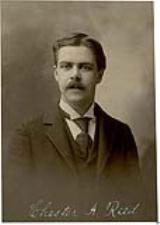Chester Albert Reed
(1876-1912)

(1876-1912)


He was an artist, a photographer, a autor and a naturalist who lived at the end of the 19thth century and the beginning of the 20th century.
Who remembers Chester A. Reed?
Though, he was the first person to publish a “Field Guide” on birds in color, in 1905. He passed away on December 16th, 1912. This website is dedicated to his memory and aims to highlight the 100th anniversary of his death.
Chester A. Reed was the person who defined, in a few years, the foundations of the ornithology hobby. He published the first ornithology magazine for the general public between 1901 and 1906, aiming specifically to the education and the conservation of bird life. He collaborated actively to the publication of the book “Color Key to North American Birds” published in 1903 by Mr. Frank M. Chapman. He published a series of Field Guides in colour, including the first book on bird identification in November 1905, the first Field Guide on flowers in colour in 1907 and the first Field Guide on New Jersey birds for the New Jersey Audubon Society in 1911. He published a series of Field Guides in colour, including the first book on bird identification in November 1905, the first Field Guide on flowers in color in 1907 and the first Field Guide on New Jersey birds for the New Jersey Audubon Society in 1911.
He became a professional of photographic hunting of birds. He published various articles in local newspapers and regularly offered conferences on ornithology to audiences of 300 to 700 people, adults and students, using his pictures. They would all listen to Chester communicating his passion.
He had many talents as an artist, a photographer, a writer and a naturalist, but the one that made him stand out and influenced his time as well as ours, was his talent as an educationalist. His skills and his desire to help people to understand and learn better brought him to publish books that are still very sought-after by collectors of older ornithology books.
We would only have to mention the way to present and document a bird on a bird identification chart by color published in his magazine “American Ornithology for the Home & School” in February 1902. The same structure is still used by contemporary authors in bird identification books (Field Guides).
To better understand Chester A. Reed’s influence and work, it is important to contextualize the time when he lived.
The end of the 19th century and the beginning of the 20th century were the start of a popular movement towards an interest in nature study. The movement was so important that the entire education system for universities, high schools and elementary schools was changed to introduce nature study to young students.
What best defines that time of “ecological effervescence” was that we would prioritize nature study by observations and experimentations outside of the classroom. Mrs. Anna Botsford Comstock (1854-1930), professor at Cornell University, published the book “Handbook of Nature Study” in 1911. It provided teachers of young students with many experiments and lesson plans to support them in their teaching process.
Mrs. Comstock’s motto was “Nature through Books”, as opposed to Mr. Louis Agassiz’s (1808-1873) motto “Study nature, not books”. Her book was published from 1911 to 1957. Chester A. Reed’s books (Bird Guide and Flower Guide) have been a recommended reference during all those years.
Chester passed away at age 36, much too young to enjoy his reputation in ornithology. In 11 years of public life, Chester:
His reputation as an artist was based on the fact that his drawings were reproduced in dimensions closer to the original. Scale reproduction was his trademark.
He passed away on December 16th, 1912, from pneumonia that killed him in 5 days. He left us a heritage in ornithology that still has an impact today.
He deserves the title of “pioneer” in the history of the ornithology hobby in America.
Here is a comment that was published in the magazine “The Auk” from The American Ornithologist’ Union association in April 1913, announcing Chester’s death.
In the death of Chester A. Reed of Worcester, Mass., on December 16, 1912, the Union lost an Associate of much promise. While only thirty-six years of age Mr. Reed had already attained a wide reputation by his publications on popular bird study. He early conceived the idea that colored illustrations were the surest means of obtaining a familiarity with birds and in all his works, the furnishing of adequate illustrations was the chief aim.
Chester A. Reed was a builder, and we have to remember him.
This website is dedicated to his memory and aims to highlight his contribution to the ornithology hobby and the 100th anniversary of his death. .